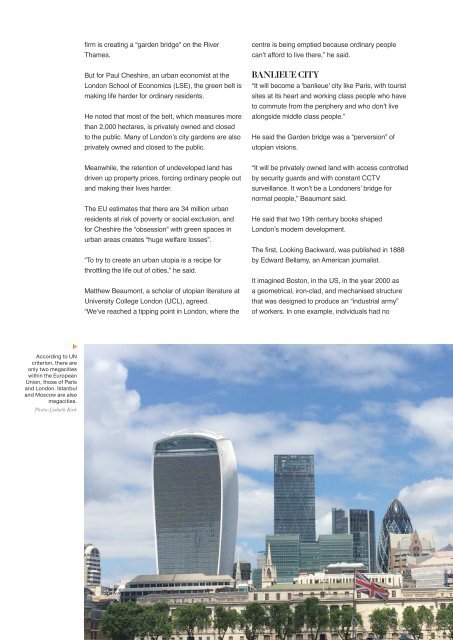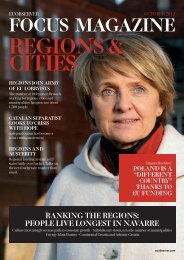Future Cities: Shaping Europe from the bottom up
The 2016 edition of EUobserver's Regions & Cities magazine looks at the cities of the future in Europe. While the EU is grappling with challenging problems - Brexit, migration, the economy, terrorism, to name a few - many European cities are reinventing themselves and tackling these problems in their own way.
The 2016 edition of EUobserver's Regions & Cities magazine looks at the cities of the future in Europe. While the EU is grappling with challenging problems - Brexit, migration, the economy, terrorism, to name a few - many European cities are reinventing themselves and tackling these problems in their own way.
You also want an ePaper? Increase the reach of your titles
YUMPU automatically turns print PDFs into web optimized ePapers that Google loves.
Thames.<br />
<br />
London School of Economics (LSE), <strong>the</strong> green belt is<br />
making life harder for ordinary residents.<br />
He noted that most of <strong>the</strong> belt, which measures more<br />
than 2,000 hectares, is privately owned and closed<br />
<br />
privately owned and closed to <strong>the</strong> public.<br />
centre is being emptied because ordinary people<br />
<br />
BANLIEUE CITY<br />
“It will become a 'banlieue' city like Paris, with tourist<br />
sites at its heart and working class people who have<br />
<br />
alongside middle class people.”<br />
He said <strong>the</strong> Garden bridge was a “perversion” of<br />
utopian visions.<br />
<br />
driven <strong>up</strong> property prices, forcing ordinary people out<br />
and making <strong>the</strong>ir lives harder.<br />
The EU estimates that <strong>the</strong>re are 34 million urban<br />
<br />
<br />
urban areas creates “huge welfare losses”.<br />
“To try to create an urban utopia is a recipe for<br />
throttling <strong>the</strong> life out of cities,” he said.<br />
<br />
<br />
<br />
“It will be privately owned land with access controlled<br />
<br />
<br />
normal people,” Beaumont said.<br />
He said that two 19th century books shaped<br />
<br />
<br />
by Edward Bellamy, an American journalist.<br />
It imagined Boston, in <strong>the</strong> US, in <strong>the</strong> year 2000 as<br />
a geometrical, iron-clad, and mechanised structure<br />
that was designed to produce an “industrial army”<br />
<br />
<br />
<br />
only two megacities<br />
<br />
<br />
and London. Istanbul<br />
and Moscow are also<br />
megacities.<br />
Photo:Lisbeth Kirk<br />
FUTURE CITIES OCTOBER 2016 — 13


















